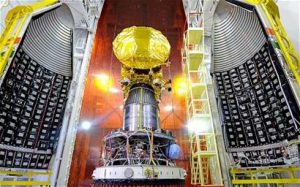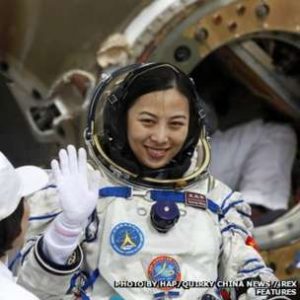Category: English Reports
July 2015 Warmest Since 1880

The analyses by NASA & Japan Meteorological Agency conducted in July 2015 showed that it was the warmest month up until now. The National Oceanic Atmospheric Administration (NOAA) agrees to the findings.
Among the records of past 1,627 months, July was the warmest. Large portions of lands on Earth were warmer than the average. But bigger contributors to the temperature were the oceans.
Nasa tweeted an animation which showed large ice loss in the Jakobshavn Glacier of Greenland. A large portion of the glacier melted in just 16 days. This glacier could add more to sea level in the Northern Hemisphere than any other factors.
The animation shows images 16 days apart from Landsat 8 satellite. One image shows the glacier’s front on 31st July and other on 16th August. A very large portion of ice melts into water.
Another thing of significance is that the first six months of 2015 were the warmest first half till date.
Ken Mok
India launches Mars mission in giant leap for super cheap space exploration

India launches Mars mission in giant leap for super cheap space exploration
Scientific experts from the Indian Space Research Organization introduced their Mars Orbiter Mission during the activity held at mission control.
When the spacecraft flew high in the air spaceward, the scientific experts from the Space Research Organization (ISRO) yelled while saying “Buriah!” – brilliant.
Scientific experts from India poured a success and hoped that it is an indication of a new generation of cheap space expedition.
The ‘Mangalyaan’ or Mars Orbiter was inaugurated on an Indian Polar Satellite Launch Vehicle from the SatishDhawan Space Centre, at Sriharikota, on the Andhra Pradesh coast.
The space exploration will cost 73 million dollars unlike with United States’ ‘Curiosity’ space exploration in year 2011 which cost billion dollars.
The aim of India is all about the testing of a remedy when it comes to value of its native rockets and technology equipment to uplift its own scientific experts and promote a new borderline on unlimited affordable space explorations.
However, some Indian space science experts have expressed a sophisticated judgment about the space exploration project as a misuse of money for a developing nation and instead of doing the said mission; India should center their attention on improving the next generation of satellite in order to participate in profitable business sector
Taj Mahal, one of the Seven Wonders of the World, is in danger
Taj Mahal, one of the Seven Wonders of the World, is in danger
The Taj Mahal, which is recognized as one of the Seven Wonders of the World, is at risk due to water and air pollution in and around the city of Agra where it is located. The Yamuna River that flows nearby increases its beauty manifold, especially in the night; however, the pollution of the river is also one of the causes for deteriorating condition of the Taj. In summer, the flow of the water in the Yamuna gets reduced considerably resulting into a breeding ground for insects. Stagnant water also causes algae formation on the river bed. These insects form greenish patches on the white marble of the Taj tarnishing its beauty significantly. In winter, when water flow is adequate no insects breed on the river bed and then no harm to the Taj Mahal.
Moreover, the air in Agra has become highly polluted due to many industries in the vicinity. Mathura refinery is only 40 miles away from the place where the Taj is located. A lot of particulate matter is generated by the burning of municipal waste. This contributes immensely to the deteriorating air quality in the city causing greenish shade on the marble surface of the Taj. Recently, the Supreme Court of India had to intervene in the matter directing the Government of India to take special measures that include inviting experts from abroad to restore the original beauty of the Taj.
The Taj Mahal was built by Shah Jahan, the Mogul Emperor in the 17th century, in the remembrance of his wife Mumtaj Mahal. The history reveals that its construction began in 1632 AD and lasted until 1648 AD that involved over 20,000 workers. The monument is visited by over 3 million tourists from all over the world every year. The Taj has been declared the world heritage site by the UNESCO in 1983.
EC allows Philippines more time to curb illegal fishing

EC allows Philippines more time to curb illegal fishing
The Philippines was given an extension for six months by the European Commission in order to complete the process and put the action plan into effect to eliminate illegal fishing so that business penalty will be blocked on Philippine fisheries commodities.
The Commission observed that some of the limitations are the poor laws, absence of effective policies to prevent illegal fishing or insufficient systems for the tracking, supervising and inspection of fisheries.
The Commission recognized that Philippines including Papua New Guinea and Ghana which have the same cases have made reasonable improvements in doing their international responsibilities by revising their legal system enhance their tracking systems and are doing a dynamic responsibility in obeying with international regulations.
EU is eager to extend the support the Philippines in order to make sure the maintenance of needs of their living and the fisheries around the world. This is based on the enlightenment of the Philippines’ state of relying in relation to coastal groups on fisheries.
The battle of EU to eliminate illegal fishing is their desire to maintain the proper use of the ocean and its resources. As the huge fish importer around the globe, the goal of EU is to block its promotion to illegally caught fish.
The Commission thinks that up to this time, the Philippines still don’t achieve its responsibilities as banner, coastal, harbor or market states in connection with international rules like United Nations Convention on the Law of the Sea or United Nations Fish Stocks Agreement.
P. Brago
Is Asia Taking the Lead in Space Exploration?

Is Asia Taking the Lead in Space Exploration?
The Vice President of China Li Yuanchao unfolded the International Astronautical Congress in Beijing which happens every year. He led the presentation of China’s large technology and encounter in ongoing global discovery and exploration in outer space. He said that space explorations can create a significant change to the challenges of humanity and China is ready to help the global community for the benefit of all. H also added that China has already 71 global agreements to 26 countries and regions.
During the Congress, which is was composed of 3,000 representatives from over 70 countries, the expanding gulf across the space separating space expeditions and upcoming strategies, the nation of space expeditions in America, was considerable. The space expeditions of China together with fast consistent speed improvements in South Korea and India, highlights the current move in international space-science power concerning Asia.
China’s connection to other Asian countries constitutes by the Asia-Pacific Space Organization (APSCO), whose presentation was very important part to China.
Ma Xingrui, the chief of Chinese space organization met the Ma Xingrui, met the Kazakstan National Space Agency chief and former Soviet cosmonaut TalgatMusabaev. During the recent visit of Chinese President Xi Jingping’sto Kazakstan, the two countries signed an agreement to implement a lawful and active system in support to space explorations.
Seth Freeman
Cholesterol: no longer a “Nutrient of concern”

When we speak about cholesterol in our body, it gives us a negative idea which is not good in our health. The name is also associated to heart attacks, strokes and other kinds of cardiovascular diseases. But nevertheless, cholesterol plays an important role for human health, as important with the water we drink and the air we breathe.
The cholesterol is connected into two things which are our body and food. The liver produces and discharges 75% of the cholesterol which flow in our blood and the existing 25% comes from the food we consume. In an average level, cholesterol is indeed very important which helps in functioning of our cells. However, the amount of cholesterol in our body has unknown conditions which already reached over 100 million Americans.
The two types of cholesterol are High Density Lipoprotein (HDL) and Low Density Lipoprotein (LDL). HDL is healthy cholesterol which is responsible in fighting bad cholesterol in our body and stops it from gathering inside the arteries. The most favorable score is 60. On the other hand, LDL which is bad cholesterol, when merged with other substances block the arteries. Foods which are high in saturated fats and trans fats will give a person a higher LDL. An LDL which scores 100 is healthy for most people but to those people with heart disease, they need to have a lower score of LDL. The recommended daily cholesterol intake is 300 mg for those physically fit individuals and 200 mg for those who are not.
There were some guidelines to follow to monitor our cholesterol intake based on doctors’ and nutritionists’ recommendations. You should be aware of the quality and quantity of food when you choose to eat in fast food restaurants. Be observant of salty foods, calories and saturated fats. Prevent eating fried foods. Controlling cholesterol intake starts from grocery store. Check the nutritional facts and serving sizes.
According to studies by Harvard Medical School, average consumption of cholesterol is not a “Nutrient of concern”.The Panel (Dietary Guidelines Advisory Committee) recommends that the dietary suggestions prevent warning about food cholesterol based on the committee’s conference last December 2014.
Lastly, be aware of your cholesterol scores for a healthy lifestyle!
R. Devi
International students face job hunting hurdles in Japan

International students face job hunting hurdles in Japan
Foreign students in Japan are rapidly embraced by the central government at least apparently.
Japan Revitalization Strategy 2014 of the government, the Cabinet Office mentioned it’s determined to engage highly experience foreign students to enhance the international competitiveness of Japan and to regenerate the economy.
The survey conducted by a labor bureau in 2013 discovered fifty percent of one thousand seven hundred seventy five little and average size companies in Japan that answered are positive in employing foreign students, expecting some laborers can enhance their world development.
Foreign students normally have a hard time writing an “entry sheet”- the comprehensive resume that many Japanese companies demand that new graduates fill in skilled Japanese to clearly show why they deserve being asked to an interrogation.
Although if international students proceed to the next level, they struggle with the recruitment aptitude exam, that are meant for indigenous people speakers in Japan to present their fundamental educational skills which include the language examination that needs excellent vocabulary.
The survey says in the interrogation of spokespersons in small companies discovered that many have neither a certain professional path that connects foreign students’ requests nor a support system like laborers’ extensive profession development in-house.
Although if an international student is employed, the struggle shows in the corporate culture in Japan.
S. Murai
Dinosaurs and their descendants

Dinosaurs are ancient creatures, which lived on the earth millions of years ago. What is left of them now are bones which have been hardened over the years called fossils. Fossils are remains of living components, which have mixed with mud and soil. After a period of 6 million years the first humans appeared on earth. Over the years’ technology improved, and life became more and more complicated until today.
It is said that the only living descendants of these magnificent creatures are modern birds. Rumour is that dinosaurs evolved into birds. The first living bird-like creatures were called Archaeopteryx. Archaeopteryx had feathers but couldn’t fly. Instead they resolved to gliding from branches. For example, a dinosaur slowly grew feathers over a period of time. With these feathers they were able to leap from tree to tree. Slowly, these feathers evolved into wings and enabled the dinosaur to glide from one place to another. Over a period of time, these wings became better and the muscles became stronger, and they finally became the first birds. It is good if birds are studied carefully, and if they are, there is a chance that we may find out more about dinosaur bones. With the dinosaurs, there were also aquatic animals.
Today’s sea creatures, such as sharks, whales and fish, are descendants of these ancient aquatic creatures. The people who excavate and study about dinosaurs are called paleontologists. When we reach a higher level of technology, we might be able to extract DNA from fossils and recreate genetically engineered dinosaurs. If we can do this, we can even reverse the extinction of these great creatures.
Student: Ashwin Raghavan
http://www.grandforksherald.com/content/how-do-you-make-bird-shrink-dinosaur-50-million-years
My Role as a citizen of Earth

Being the citizen of earth there are several responsibilities. My role as a citizen of earth is to protect and save the earth which is most important and necessary responsibility. God has created the earth for human comfort. Humans have to develop friendly relationship with nature and not enmity. If we do not save the earth human life would be over. We should be concerned about the health of our planet and be humble to save the earth. We should save the earth because it’s home for innumerable living organisms.
Measures to protect our mother planet earth
- Avoid pollution:
It’s better to live in a clean healthy environment than a polluted one. Living organisms needs Atmosphere to survive. A gas like oxygen in atmosphere is required for the survival of living beings. Carbon dioxide is also needed to keep the plants alive. Pollution affects the life on the Earth. I will become an air pollution activist by joining local groups that work to avoid air pollution and find a way to get involved in my role.
- Afforestation:
Plant trees that help to clean the air. Develop forests which will provide habitat for many animals. Plants are also economically very useful. The wood from the trees are used in manufacturing furniture. There are some medicinal plants that are used in Ayurvedic products. Aim to plant trees which will grow taller and provide shade.
- Maintaining soil fertility:
Protecting the health of the soil by using cloth bags instead of plastic because it takes hundreds of years to decompose; as they decompose some toxins are released into the soil which reduces soil fertility. Use products which are renewable and reusable. Do not use chemical fertilizers it also hinders soil fertility instead use organic manures or bio fertilizers.
- Work to stop mining:
Blasting operations are planned for mine plan, due to this land becomes unhealthy and landscapes will be destroyed. It also affects the habitat of flora and fauna. Stop mining by being politically active to stop mining in restricted areas of earth.
- Resource depletion:
Social, economic and scientific developments of country are linked to energy sources. The conventional sources energy being used for long time are generally non-renewable. They include coal, petroleum, natural gas and electricity. We are using them so extensively that their reserves are depleting at a fast rate. At the same time, it is becoming increasingly difficult to discover new deposits. So they should be used in a controlled way.
Another problem which I see is poverty. It indicates a condition in which a person fails to maintain a comfortable lifestyle. As a citizen of earth it is our responsibility to contribute our share to ensure all possible ways to overcome poverty. I would try my level best to reduce poverty in my country. If we really want to throw poverty away, we should stop speaking about it and take some measures.
Measures to reduce poverty:
- Donations to poor people:
Donations are the best way to overcome poverty in small scale. I would open my own NGO to help poor people like providing food, clothes, education etc. By paying taxes which helps in the development of nations. Donating to trusted organisations so that it can be used in a useful manner. Live a simple life so that others can also lead a simple life.
- Educating young people:
Education is the most effective way to reduce poverty. Education strengthens the abilities of individuals and makes them skilled to work and gain income to satisfy his wants.
- Increase employment opportunities:
Unemployment is a situation in which a person is ready to work physically or mentally at a given wage rate but not getting employment opportunities. Hence increase in employment ensures a comfortable life.
- Learn about money management:
Savings is a better way for betterment in life of an individual. I would try to save my income by spending money wisely and leading a simple life. I would consult a financial institution to create savings plan.
If all these measures are implemented by all the nations of the world then poverty can be reduced from the whole world.
Student: Meghashree
http://californiagermans.com/tag/orange-county-california/






